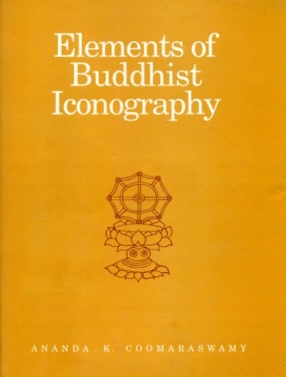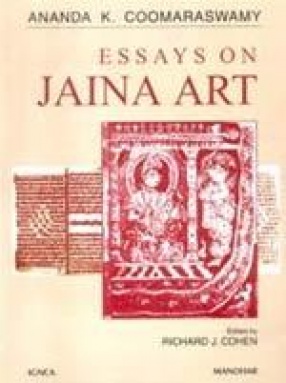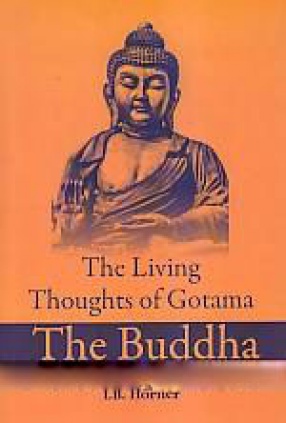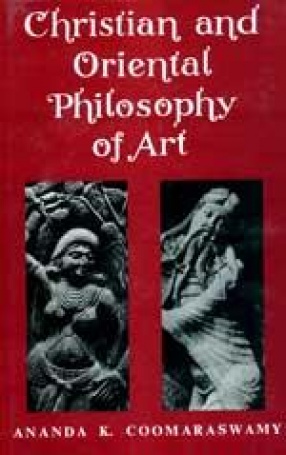
Ananda K Coomaraswamy

25 books


















Ananda Coomaraswamy's Early Indian Architecture-Palaces is, like all his writings, a masterpiece. In this study, he has discussed about prasada or the palace on the basis of the evidence from literary sources and early Indian sculptural examples. He has examined the various parts and components of the palace such as the storeys, the streets leading to and inside the palace, walls, gateways, different quarters and apartments, pillars, windows, etc., besides the ...

The present work is an analysis of Buddhist symbolism in historical perspective. In author's view Buddhist symbolism, in art and religion, is but a part of the main current of Indian religion and art and has to be studied in that context. Early Indian art is, thus, essentially the continuation of a mainly aniconic "Vedic" style and the compositions are comprehensible only with reference to Vedic notions. The present work studies the fundamental elements ...

This book gives an account of the life of the Buddha and an exposition of the religion and philosophy the Buddha propounded. This also analyzes the origins of Buddhist thought and traces its development from Hindu philosophical systems. Developments in Buddhist thought since the death of the Buddha are also dealt with as are Buddhist literature, sculpture and painting, both in India and in other pars of the world to which Buddhism spread.
The aim of this," ...

The collection of essays by Ananda Coomaraswamy on Indian art and culture and other themes, published under the title The Dance of Shiva reflect the many-sided genius of this great savant. The fourteen essays in this collection critically deal with aspects of Indian ethos, art and aesthetics, philosophy, music and Indian women besides essays on Indian and western and ancient and contemporary themes.
Coomaraswamy's discussion on these wide ranging themes with his ...


A literary work built up with parallel citations is apt to grow in the compass of the author himself, from his encyclopaedic scholarship. This revised edition of one of Coomaraswamy's most significant writings is now being issued by incorporating his own additions to the printed first edition of 1942.
The Indian theory of government is expounded on the basis of the textual sources, mainly of the Brahmanas and the Rigveda. The mantra in the Aitareya Brahmana ...


Particular significance attaches to Yaksas in Indian mythology, religion and art. Their almost universal presence in the earlier Indian religions, Hindu, Buddhist and Jaina, wherein they are invested with peculiar traits and powers, indicates their importance. Ananda Coomaraswamy’s Yaksas is an attempt at bringing together the mass of information from literary and monumental sources about Yaksas and Yaksis, their origin, and development from the conceptual, ...

Philosophy, ritual, and mythology are the three pillars of all ancient religions. But in India in particular, mythology has been an extremely important medium for teaching abstract spiritual truths, and it has had a profound influence not only on the religious traditions of the country but also on Indian society. To Western-educated readers, the numerous concepts, characters, and ideals presented in Indian mythology often seem bewildering at first glance. Yet, ...

Fifteenth in the series of Collected Works of Dr. Ananda Coomaraswamy in the IGNCA’s publication programme, this volume deals with his contribution to the study of Jaina art. His writings on Jaina art span the entire period of his active working life as an art historian. He published his first article on the subject in 1914, and ended wiwth a book review in 1943, four years before his death. Jaina art and its symbolic inventory held a special place in ...

This is an unabridged reissue of a basic work upon Asiatic art principles first issued by Harvard University Press in 1934. Written with all the author's enormous erudition in art history, aesthetics oriental languages, philosophy and religion, it analyses the community of theory behind medieval European and Asiatic art. The author demonstrates that both differ radically from post-Renaissance European art because of a basic philosophic orientation on the part of ...

Ananda K. Coomaraswamy's Spiritual Authority and Temporal Power in the Indian Theory of Government traces the source of Indian Political theory to the words of the marriage formula: "I am that, thou art This, I am sky, thou art Earth." Long ago mankind discovered that institution of state, or something similar to it, alone would ensure their survival. They entrusted their material and spiritual welfare to the king and the priest, the two principal ...

The book, 'Essays in National Idealism' in the words of the author himself, represents "an endeavour towards an explanation of true significance of the national movement in India." In fact, it marks a stage of development of Coomaraswamy's own thought reflecting perhaps the quest for his own identity. In his view, the Indian National Movement had its base in an idealistic movement, for it represented a struggle for spiritual and mental freedom from the ...

The collection of essays by Ananda K. Coomaraswamy on Indian art and culture and other themes, published under the title The Dance of Shiva reflect the many-sided genius of this great savant. The fourteen essays in this collection critically deal with aspects of Indian ethos, art and aesthetics, philosophy, music and Indian women besides essays on Indian and western and ancient and contemporary themes. Coomaraswamy's discussion on these wide-ranging themes with ...

The Mirror of Gesture is the English translation of the Abhinaya Darpana of Nandikesvara which was originally published with a Telugu interpretation by Madabhushi Tiruvenkatachari of Nidamangalam in 1874. The Abhinaya Darpana, according to Nandikesvara, who is a legendary figure, is an abridgement of the Bharatarnava, an exposition on the art of dancing. For those not acquainted with the Indian dramatic technique, it may be difficult to understand the importance ...

Ananda K. Coomaraswamy's Early Indian Architecture is a study of the subject based mainly on the information as available in early Pali literature and as represented in the reliefs of Bharhut, Sanchi and Amaravati. The work is divided into two parts: Part I deals with cities and city-gates, etc. while Part II is on the Bodhi-gharas i.e. representations of the Bodhi-tree with or without a temple structure. Coomaraswamy has assembled the data systematically and in ...

Ananda Coomaraswamy's Hinduism and Buddhism, like all his writings, is a masterpiece. In this work he sets forth his ideas with his usual depth and insight to discard the wrong notions about the divergence in the basic philosophies of these two major religions that have been propounded by 'European scholars and by Indians trained in our modern sceptical and evolutionary modes of thought.' In Hinduism and Buddhism Coomaraswamy has tried to show that the essentials ...

The compilation of articles is a glaring example of the multidimensional talent of Ananda K. Coomaraswamy (1877-1947), who was not only a pioneer historian of Indian art, a master-interpreter, one of the most versatile of this century whose scholarship and knowledge knew no bounds, but a universal man at the same time, the one who urged the Indians to be conscious of their glorious heritage. Coomaraswamy was the harbinger of Indian nationalism but his outlook was ...

The nine essays in this book are among author's most stimulating. They discuss such matters as true function of aesthetics in art, the importance of symbolism, and the importance of intellectual & philosophical background to the artist, they analyse the role of traditional culture in enriching art, they demonstrate the abstract art and primitive art, despite superficial resemblances, are completely divergent and they deal with the common philosophy which ...

'Today, if India takes her due rank as first-class artistic power, it is in large measure owing to Coomaraswamy'-so said the distinguished British artist Sir William Rothenstein of Ananda Kentish Coomaraswamy, the celebrated author of this work. To know the magnitude and quality of the work done by this great savant is to know the truth and value of this tribute. His pioneering work put the long neglected Art of India before the world of art where it holds its ...

Indian writers have long been interested in the classification of heroes and heroines in well-defined types. Such classifications are typically developed in Sanskrit treatises such as Natyasastra, the Sahitya-Darpana, and Kama Sutra and in other works and later in vernacular literature of Hindustan, chiefly in Rasikapriya, Satsaiya, and the Bhasa-bhusana.

Ananda K. Coomaraswamy's The Origin of the Buddha Image is a detailed study and analysis of the controversial problem. In the present monograph, with his usual acumen and deep understanding of the subject, Coomaraswamy has laid bare the facts which clearly show that the Buddha image was a product of the Indian mind. In this detailed excurses, he has discussed the problem not only with a view to prove that the Buddha image originated out of the pre-existing Indian ...

Myths of the Hindus and Buddhists is a single volume comprising the most important stories of Indian mythology taken from the two great epics Mahabharata and Ramayana, with additional tales from the Puranas, the Vedas and assorted narratives of Krishna, Buddha and Shiva. The book prepared by two of the foremost scholars and writers on Indian life, explains and interprets Indian ways and thoughts.
